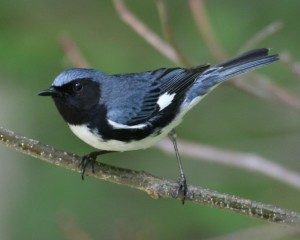Each of us has endless opportunity to make small decisions with positive results. The ethical decisions of a single individual are unlikely to make a large difference, but when we start acting collectively the world becomes a better place. Many of those positive decisions are related to our purchase of everyday products, and your choice of coffee may help our feathered friends.
Traditionally, coffee plants were grown under shade trees. This situation changed when varieties of coffee were developed that had better productivity when exposed to full sunlight; most coffee is now grown without shade trees. Over the past couple of decades, research has shown that coffee plantations with abundant shade provide habitat that is far more valuable to insect-eating birds. These include several species of New World warblers that breed in temperate regions but spend the non-breeding seasons in the tropics. This relationship is not all one-way. Warblers eat insects, and it is apparent that their foraging benefits the coffee farmer by eliminating pests. With support from such agencies as the Smithsonian Migratory Bird Centre, the popularity of shade-gown, bird-friendly coffee is growing.
Aaron Spidal and Matthew Johnson of Humboldt State University in Arcata, California recently asked a very interesting question about migrant warblers and coffee farms. Do all members of a particular species of warbler have equal access to the high-quality foraging opportunities provided by shaded coffee farms, or are some individuals forced to live on sunny farms? Might older birds, or behaviourally-dominant males, prevent females and young males from feeding in shady situations?
In December and January of 2010-2011 and 2011-2012, Spidal and Johnson mist-netted birds at coffee farms in Jamaica. The nine sites chosen for study differed greatly in the amount of cover, from highly shaded to fully sunlit. Nearly 1400 hours of trapping resulted in 298 captures of migratory warblers of 14 species. The most abundant of these were the Black-throated Blue Warbler, the American Redstart and the Prairie Warbler.
The researchers found that coffee farms with differing amounts of shade did not differ in the number of adult and young birds, by any particular species or for all species combined. However, there was a significant positive relationship between the proportion of males at a site and its cover by shade trees. This was true for each of the three most common warbler species, and for all species combined. Shady conditions provided better foraging opportunities, and males occupied those sites more frequently than females.
The sexual subdivision of habitat seen by Spidal and Johnson might be a result of sexual differences in habitat preference. Perhaps there is something special about the anatomy or behaviour of females that make foraging in sunny coffee farms the better choice. The researchers favored the alternative explanation that males were dominant, and so excluded females from the superior foraging opportunities provided by shady coffee farms. Although further study would be required, Spidal and Johnson felt that the proportion of males at a Jamaican coffee farm might serve as an index of habitat quality.
At present, it is unlikely that you will find shade-grown, bird-friendly coffee in your local grocery store. If bird-loving consumers make their wishes known, that situation is likely to change in the years to come.
Spidal, A. B., and M. D. Johnson. 2016. Sexual habitat segregation in migrant warblers along a shade gradient of Jamaican coffee farms. Journal of Caribbean Ornithology 29:37-42.
Photo credits: Black-throated Blue Warbler – www.pinterest.com; Shade-grown coffee plantation - www.alamy.com/stock-photo/coffee-plantation-landscape.html



